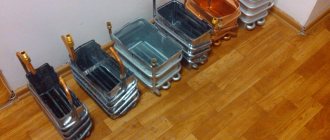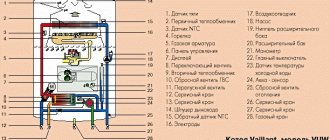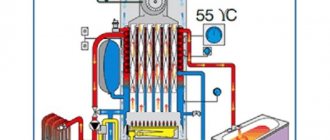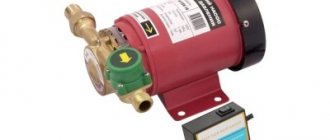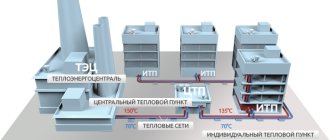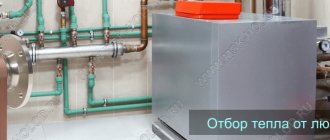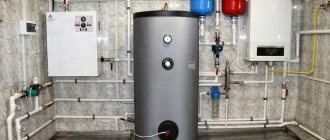Hot water heat exchangers
Hot water supply systems include various components and assemblies. One of the most important are heat exchangers for hot water supply. Let's look at them in more detail, tell you about their purpose, functions and types. We will also pay attention to designs, principles of operation and connection, maintenance and much more.
Principle of operation
Heat exchangers for preparing DHW water operate on a non-contact principle. Their design may be different, but the principle of operation is the same - they work on the principle of heat transfer. There is a heated coolant (in this case from the heating system), which is supplied to the pipes/channels of the heat exchanger. The hot coolant gives off some of the heat to the tubes through which it flows. Other parallel channels carry water that needs to be heated. In contact with the walls heated by the coolant, it heats up. This is exactly how a heat exchanger for hot water from heating works.
Schematic diagram of using a heat exchanger for preparing hot water from heating
For heating to be effective, the heat exchanger must be made of a material with high thermal conductivity. Usually these are metals - copper, stainless steel. Copper is an expensive metal, but has excellent thermal conductivity. Stainless steel conducts heat less well, but due to its strength, the walls can be very thin, which makes such heat exchangers also effective.
Types of plate devices
Collapsible
. The models consist of several individual plates. A collapsible plate heat exchanger for domestic hot water allows you to change the configuration in accordance with the required performance. The slabs can be easily removed and added to the frame. Collapsible models are preferable for installation in systems with low water quality, as they allow you to regularly clean the elements from plaque manually.
Soldered
. The heat exchanger is non-separable and has a sealed housing. Soldering devices are characterized by low weight, compact dimensions, resistance to high temperature and pressure of the working environment, and long service life. Maintenance of heat exchangers is carried out using solutions of chemically active substances: the liquid is poured into the equipment and left for some time to remove deposits. During cleaning, the device is turned off (2–3 hours).
How to use heat exchangers to obtain hot water from heating
There are several possibilities to heat water for domestic needs using a heat exchanger and heating:
- Heating running water. Disadvantages - limited possibilities for hot water consumption, lack of reserve, difficulty in maintaining a stable temperature (you need to organize a mixing unit or install a controller). Advantages: little space required, few components.
- Heating water in some container. The heat exchanger for hot water from heating is lowered into some container filled with water. In fact, this is already an indirect heating boiler. But a heat exchanger is installed in it and it is connected to the hot water supply. But we are not talking about them now, so not in this article.
The most basic heat exchanger is a pipe through which the coolant flows
Types of heat exchangers for hot water
In general, there are many designs of heat exchangers, since they are used frequently in various devices. Let's talk in more detail about the most affordable, reliable and effective. For domestic purposes, two types are used:
- Plate (soldered or collapsible).
- Shell and tube.
Heat exchanger for hot water from heating: in the private sector, two types are used - plate (left) and shell-and-tube (right).
In them, the thermal media - the coolant from the heating system and water from the cold water supply (cold water supply) do not mix. The channels through which they flow are in no way connected with each other. Therefore, when pumping drinking water for heating, we get the same at the output.
Lamellar
A plate heat exchanger for hot water from heating consists of several metal plates with extruded passages. They are assembled in mirror image, so that channels for the circulation of liquids are isolated from each other. The plates are made by stamping from sheet metal. Thickness - up to 1 mm. The metal is usually stainless anti-corrosion steel, but it is also made of titanium and special alloys.
The channels on the plates are most often made in the form of equilateral triangles with different angles. The sharper the angle, the faster the fluid moves; the blunter, the greater the resistance and slower the movement. According to the flow pattern of media through channels, plates can be single-pass or multi-pass. In the first, the direction of movement of the media does not change from beginning to end. Another distinctive feature is that the media move in countercurrent (for greater efficiency).
In multi-pass plate heat exchangers, the channels are located so that the media change direction of movement several times. Their structure is more complex, the cost is higher, but they are able to extract maximum heat (high efficiency). In multi-pass heat exchangers, it is possible to achieve a small difference in the temperatures of both fluids.
According to the connection method, there are two types - collapsible and soldered. The plates of collapsible plate heat exchangers are connected using special elastic gaskets (made of rubber, fluoroplastic). To ensure the tightness of the channels, they are tightened with metal tie rods. For stabilization, the structure contains two massive plates - fixed and movable. Rods are fixed to the fixed one, and plates with passages are strung on them. The more there are, the greater the power and the greater the heat transferred. The movable plate is installed last, the nuts are screwed onto the couplers and tightened until the channels are sealed. Thanks to this design, these heat exchangers can be disassembled, cleaned, and plates can be added or removed. And this is the advantage of this design. Disadvantage - a plate heat exchanger for hot water from heating has greater weight and size (when compared with soldered ones).
Two types of plate heat exchange devices - soldered (left) and collapsible (right)
Brazed plate heat exchangers are factory assembled. Stainless steel plates are welded in an argon atmosphere, which avoids corrosion at the welding points. Brazed plate heat exchangers are non-separable, which can make cleaning difficult. Their advantage is their more compact size and lighter weight, since there is no need for stabilizing plates.
Each heat exchanger has inputs and outputs for connecting coolant (from heating) and water. These outlets can be in the form of a flange, welded pipe, or threaded connection. They allow you to connect a heat exchanger for hot water from heating to pipes of any type.
Shell and tube
Shell-and-tube heat exchangers for hot water from heating are simpler in design, but less efficient, which is why they must be large in size to ensure the required temperature. Low efficiency, large size and material consumption are the reasons why they are used less often in everyday life. But their design is more reliable - they can withstand harsh operating conditions. So this type of heat exchange units is more often used in industry.
Shell-and-tube heat exchangers are a shell-pipe with smaller tubes inside. Usually these are copper tubes, but they can also be made of other materials, not only metal.
Shell and tube heat exchanger for hot water supply - design and principle of operation
Heated water moves through thin tubes, which is then supplied to the taps. The coolant from the heating system moves through the space inside the casing, which is not occupied by tubes with heated water. The direction of movement is countercurrent. This ensures greater heat transfer. But it is worth saying that the overall efficiency of such installations is lower than plate ones.
Types of heat exchangers for hot water systems
Today there are many of them, but among all, the two most popular for everyday use are shell-and-tube and plate-type systems. It should be noted that shell and tube systems have almost disappeared from the markets due to low efficiency and large sizes.
A plate-type heat exchanger for hot water supply consists of several corrugated plates located on a rigid frame. They are identical to each other in design and dimensions, however they follow each other, but according to the principle of mirror reflection, and are divided among themselves by specialized gaskets. Gaskets can be either steel or rubber.
Due to the alternation of plates in pairs, cavities appear that during operation are filled with either heating liquid or a heat carrier. It is due to this design and operating principle that the displacement of media between themselves is completely eliminated.
Through the guide channels, the liquids in the heat exchanger move towards each other, filling the even-numbered cavities, and then exit the structure, receiving or giving up some of the heat energy.
Scheme and principle of operation of a hot water supply plate heat exchanger
The more plates in number and size there are in one heat exchanger, the larger the area it can cover, and the greater its productivity and useful effect during operation will be.
For some models, there is space on the direction beam between the locking plate and the frame. It is enough to install a couple of slabs of the same type and size. In this case, the tiles installed additionally will be installed in pairs.
All plate-type heat exchangers can be divided into several categories:
- 1. Soldered, that is, non-separable and having a sealed main body.
- 2. Collapsible, that is, consisting of several individual tiles.
The main advantage and plus of working with collapsible structures is that they can be modified, modernized and improved, from removing unnecessary ones or adding new plates. As for soldered designs, they do not have such a function.
However, plate-brazed heat supply systems are more popular today, and their popularity is based on the absence of clamping elements. Thanks to this, they are distinguished by compact sizes, which do not in any way affect their usefulness and performance.
Connection diagrams
In addition to the type of heat exchanger, you must also choose the method of connecting it. There are several standard schemes. In any case, two outputs are connected to heating, one to cold water supply, one to hot/heated water distribution.
Parallel (standard)
In the simplest case, a heat exchanger for hot water from heating is connected in parallel to the existing system. This scheme is the easiest to implement, but for sufficient heating it is necessary that the coolant moves actively. That is, it is necessary to have a circulation pump in the coolant supply. In systems with natural circulation, this type of installation is ineffective.
Heat exchanger for hot water from heating: parallel connection diagram
During installation, the coolant supply is always connected to the upper pipe, and the return pipe to the lower one. When connecting water, the situation is the opposite - cold water is connected to the lower pipe, and the hot comb is connected to the upper one.
Heat exchanger piping diagram for DHW from heating
The simplest piping scheme contains shut-off valves on all four pipes - for the possibility of shutdown, cleaning, and maintenance. A mud filter with a fine mesh is also installed at the heating inlet. Since the gaps in the heat exchanger are very small, the ingress of scale or other contaminants can cause blockage of the channels. It is advisable to install the same filter at the cold water inlet - the equipment will operate longer.
This scheme can be improved by recirculating hot water in the DHW comb (looped after the last point of analysis). With this construction, the heat of unused hot water is not lost, but is used: water from the hot water comb is mixed with cold water from the water supply. It is no longer completely cold that is supplied for heating, but warm. The heat exchanger for hot water from heating only brings it to the required temperature.
Connection with DHW recirculation circuit
When disassembling heated water, mainly water from the cold water supply pipe is used for heating. When there is no analysis, the pump “drives” warm water in a circle, the load on the heating boiler is very small.
The temperature is controlled using a sensor and a control valve installed on the return (you can also install it on the supply). The readings from the sensor (water temperature in the DHW outlet branch) are sent to the control device. Based on the results of comparison with the set data, the intensity of the coolant flow is adjusted, thereby regulating the heating intensity.
Two-stage
The schemes described above are good for everyone, except that for heating a large flow of coolant must pass. Otherwise, the water will not have time to warm up. The second drawback is that you have to “turn off” the coolant flow from the heating system. With high flow rates and insufficient power of the heating boiler, temperature drops may be noticeable in cold weather. For a more rational use of heat, we came up with a two-stage system for connecting heat exchangers.
One of the options for two-stage connection of heat exchangers
In this case, the primary heating comes from the heating return pipeline. Thus, energy resources are used more efficiently. The temperature is brought to normal by reheating, but from the coolant that is supplied. You can connect the heat exchanger for hot water from heating in parallel - as in the top diagram. The second option is presented on the bottom - into the gap in the supply pipe from the heating system.
Two-stage heating option
When using the second scheme, primary heating occurs from the return. The water heated in this heat exchanger is supplied to the second one installed in the supply. Here it is brought to the desired temperature and sent to the consumer.
There is also a two-stage heating scheme using heat from hot water recirculation. In this case, the heat of previously heated water is rationally used.
Primary heating is from hot water recirculation, final heating is from the heating system
When using any of these schemes, the load on the boiler is significantly reduced. The heat that was not previously used is utilized. Thus, these schemes help save on energy.
For normal operation of a heat exchanger connected according to any of the schemes, technological requirements must be observed during installation. It is imperative to observe the slope of the hot water pipes towards the disassembly points. If the route passes above the door, an air vent is installed at the highest point. In addition, with a long route, additional automatic or manual devices for air release (air vents) are required. Otherwise, there may be problems with water supply.
What are heat exchangers used for in hot water supply systems?
As the name implies, a heat exchanger is a device for exchanging heat (sorry for the tautology). In hot water supply systems (abbreviated as DHW), they are used to transfer thermal energy from water heated by a boiler to water that is disassembled from taps and used for domestic needs. Very rarely - as a rule, at the boiler houses or thermal power plants themselves, water for hot water supply is heated by steam.
Why do they not take water heated in a boiler for hot water supply, but use heat exchangers?
At first glance, yes, it seems stupid to heat water once in a boiler for heating, and then transfer the heat from it to other water for hot water supply. But everything is explained.
- The water in the heating system (called network water) is most often specially prepared. In order to avoid scale on the walls of pipes, boilers and heating devices, calcium and magnesium salts are removed from it. Such water turns out to be soft and does not satisfy thirst.
In addition, they try to remove dissolved air so that air pockets do not form that interfere with normal circulation.
Interesting fact. In the middle of the last century, in some heating systems, hydrazine was added to the network water to remove air. Such water was not only soft, but also poisonous.
Note: It is also unprofitable to use equipment capacity and chemicals to prepare water for large quantities that will be disassembled by consumers.
- When disassembling network water, its loss is possible - if the replenishment is not turned on in time (or the automation does not work). This threatens an emergency situation and even a boiler explosion.
- Heating systems are regulated to ensure the required water flow in all areas. If it is unevenly taken from different points, such an adjustment cannot be made.
- The higher the pressure in the heating system, the more efficiently it works. For water supply, excessive pressure is not needed. Moreover, many components and fittings on hot water supply networks are not designed for them.
- Network water can be heated above the standard for a hot system. You can adjust the temperature on the heat exchanger by changing the flow rates.
- For water supply, pipes must comply with sanitary standards. As a rule, they have a zinc coating on the internal surfaces. The price for them is naturally higher than for regular black ones. Laying the entire heating system from such pipes is not economically profitable.
But it should be noted that there are hot water supply systems in which the water for them is prepared directly in the boiler. These are small heating systems with hot water supply (for one or two apartments), which use double-circuit boilers. They have a special circuit specifically for heating water.
Of course, in large central heating and water systems it would be possible to install separate boilers for hot water. But this is disadvantageous in that it complicates the system, and in addition, three or four pipes would have to be pulled to each house separately for network water and separately for hot water. Therefore, only two are laid, for heating, and heat exchangers are installed either in each house or in a group of them in the central heating point (central heating point).
By the way, in addition to the name “heat exchanger”, specialists who install and operate heating and hot water supply systems very often use the word “boiler”. In our article we will not deviate from traditions, and we will also apply it.
